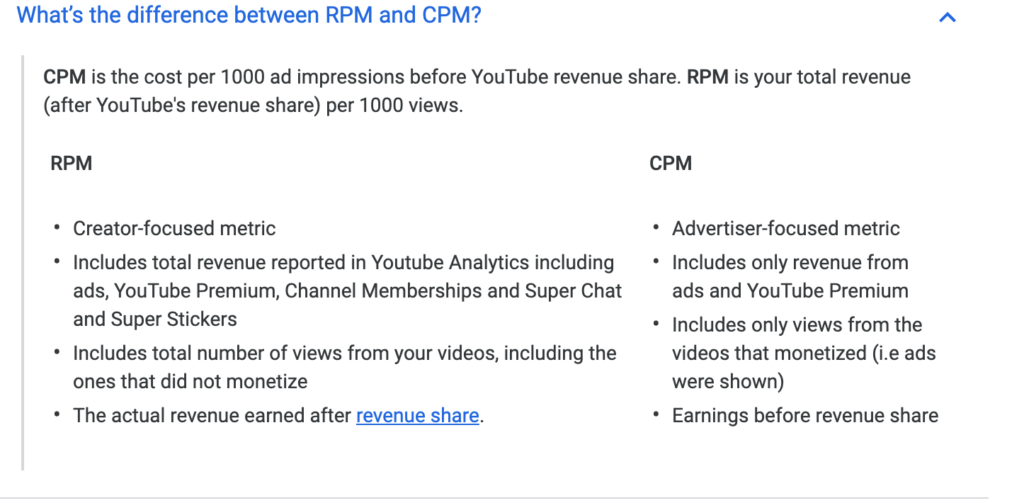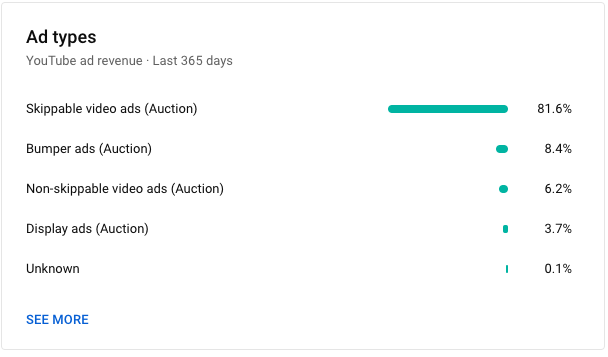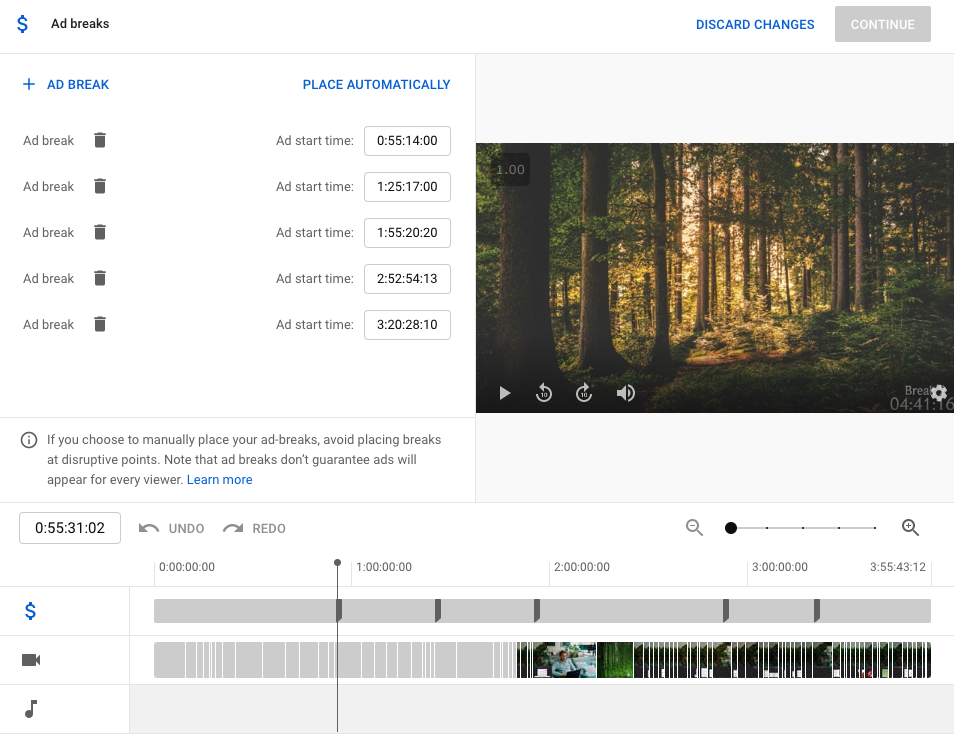How YouTube Revenue works and how to optimize your videos for $11 min read
In a previous post, I talked about how much money I made on YouTube. I really never expected to make that much money after a hobby. There are certain things you need to do before your YouTube channel can start making money. There are certain things you should think about as you grow your channel. In this post, I’ll tell you how YouTube decides how much to pay you, how to optimize your channel to make money, and how to optimize yourself on the internet to make money in the future.
How Much Other YouTubers Make
These are the people that showed me that it is possible to make a real living on Youtube. It is possible to do well off of doing something fun. This is a good place to start because it shows you the possibilities around YouTube creators of small to medium-large size.
How much does the average creator earn from Adsense? I did not take this from SocialBlade (as many creators say this number is not accurate). I took these numbers directly from creators who speak publicly about how much they make from YouTube Adsense. Also, keep in mind, this is just Adsense. Many of these creators have other sources of income which double or even quadruple their Adsense income.
- I made $600 @ 3k Subs after 2 months of being monetized
- Jimmy Tries World made $13,000 @ 20k Subs over 2 years of being monetized
- Cathrin Manning made $88,000 @ 300k Subs in 2020
- Shelby Church made $169,000 @ 1.5 million Subs in 2020
- Ali Abdaal broke down things really nicely, as he always does:
- 2017: $0 @ 1.6k Subs
- 2018: $17,000 @ 120k Subs
- 2019: $45,000 @ 450k Subs
- 2020: $137,000 @ 1.3 Million Subs
One thing to keep in mind is that the Subscriber count doesn’t matter. YouTube doesn’t pay you based on your Subscriber count. That’s not how it works. YouTube only pays you based on how many people watch your videos.
The Subscriber count matters because that’s a good estimation, or safety net, for the number of views your videos will get. An average subscriber to view ratio is about 10%. That means if you have 1 million subscribers, your videos will usually, at a baseline, get 100k views. Because of this, channels with more subscribers usually get more views. But, there are no guarantees. I have seen large channels that, usually after taking an extended break, come back to have their videos get 1% or less of their subscribers to watch their videos.
That’s one reason I’m so scared to slow down on uploading. I’m scared I will lose some of the amazing people following me from the beginning.
Ok, so we understand that more views usually equals more dollars, but there are some exceptions.
Some videos make way more, like five times more, with the same amount of views? Why is that? Well, I did a deep dive and found out.
How YouTube Revenue Works
RPM and CPM
RPM is the number that matters. I think it’s the “new” CPM. RPM takes into account YouTube’s cuts and views that weren’t monetized. So it’s the money you are actually getting per 1,000 views or “revenue” per 1,000 views.
CPM is the cost an advertiser pays for 1,000 ad impressions. So this could be anything from the skippable ads you see to the little pop-up banner ads you see. I think this number is less relevant as this number is just the gross money advertisers are paying for your video.
RPM is the money you get for 1000 views, and CPM is the money advertisers have to pay per 1000 views.
Here’s a nice chart from YouTube:

As you can see from the aggregation of all of my videos, my RPM is about 1/3rd of my CPM. That means YouTube is taking a decent chunk, and many of my views are “non-monetized views.”

Now, this is a solid chunk, and I wish it were less, but do I have a choice? No. Also, do I want to be involved in all the organizing, negotiating, legal ring around the rosy, and headaches associated with finding and working with advertisers? No, no, I don’t. I thought I would get $1 per 1000 views, and, based on this RPM, it looks like I am getting 3x per 1000 views, which is pretty nice. This rate is still higher than I thought.
What contributes to this RPM, well, the ads on the videos. There are many different kinds of ads YouTube can place on your videos.
Ad Types
The type of advertisement that makes my channel the most money is skippable video ads. This seems to be a theme across most other channels too.

Of course, there are also bumper ads that pop up on the bottom of videos, but these only accounts for 8.4% of my income.

This differentiation between which ads make more money is important. I will tell you why it’s important later. However, in general, usually, I enable all of them. My feeling on this is people who watch YouTube are used to ads. They x them or skip them and usually aren’t too annoyed by them. The only time I actually edit the placement of ads is “mid-roll ads.”
For example, in my study with me videos, I only place ads in breaks. I don’t want ads interrupting the study times! Otherwise, I let YouTube place ads where they think best.

Ok, we know where the money is coming from and how you get paid as a YouTuber now. How do we maximize this payment? If we can learn more about why certain videos make more money, we can optimize our videos to make that little extra cashola.
Which Videos Make More Money
Certain videos make more money than other videos with fewer views. Why is this? It comes down to a couple of things. One important thing is the money comes from Ads, right? Well, companies will “bid” on a $ amount per 1,000 views based on the video’s demographics like:
- Age of average viewer
- Genre of video
- Gender of average view
The “bidder” (company) willing to pay the highest price wins. So the company that is willing to pay the most money per 1,000 views wins the bidding war, and their ad will be placed on ads that meet certain demographic criteria.
So if your videos meet the most popular demographic criteria, your video will most likely make more money. However, beyond how much these various companies are willing to pay, other things come into play.
- Length – how long is a YouTube video
- YouTube Premium Views – how many viewers have YouTube Premium
Looking at my videos, some videos seem to make more money, per 1000 views, than any of my other videos. So, that most likely means advertisers are willing to pay a higher premium, a higher rate, to have their ads displayed on those videos.
For example, it seems my MCAT videos make the most RPM for some reason, with my video on Improving your MCAT score 10 Points earning $10.18 RPM while my Ultimate Morning Routine Parody only earns $1.90 RPM.
This makes sense to me. Advertisers for MCAT prep courses and books are willing to pay a pretty penny for people that click on this kind of video because the people watching MCAT prep videos are most likely in the market for preparation materials. So advertisers have a better chance of selling their MCAT prep materials on my MCAT videos than they would on unrelated videos, like on how to get a fantastically healthy body shine by swimming in boiling water (which you should never do, obviously).
So, if the only reason I was on YouTube were to make money, I would pump out MCAT videos, but that isn’t the main reason I’m on YouTube. Also, I never want to think about the MCAT again.
I have been following my own personal mantra and will continue to follow it for making videos:
Make videos that you enjoy making that provide value, do that consistently.
How to Get Started Making Money on YouTube
First of all, as I said earlier, you shouldn’t be on YouTube to make money. Sure it’s a major reason I am on YouTube, but it’s not the number one reason. I talk about whatever I want, like this post, because I find it interesting and fun to talk about. This will not be my best-performing post. In fact, it will probably be one of my worst-performing posts. I am just making it because it’s cool to me.
Ok, so you have a YouTube channel, and you want to start earning money, what do you need to start getting that sweet Adsense cashola?
Minimum For Entry
To be monetized on YouTube, you need 1,000 subscribers and 4,000 hours watched.
I have a post and video on how to get those first 1,000 subscribers.
It took me 150 days and 22 videos to reach that first 1,000 subscribers. This is the hardest grind there is. Really. Getting to 10,000 subs and 100,000 subs was much easier than those first one thousand. This is where most people quit. This is where most people give up.
You have to believe in yourself. You have to believe you are putting out new and exciting content that you would watch. Believe that, post the best content you can post, and post consistently (I think once a week is a nice number), and you will hit these requirements.
Optimize Videos for $
Certain videos just won’t be allowed to be monetized at all. Some examples are:
- Sexually explicit videos
- Stolen Content
- Self Injury
YouTube has a confusing policy on monetization. In general, to make videos that are optimized for making money, your videos should be:
- Child Friendly – Avoid cursing and other explicit content
- Original
- Longer than 8 Minutes – This way YouTube can run multiple ads, or “mid-roll” ads this way. Other creators have talked about how this has quadrupled their YouTube Adsense income.
These strategies make your videos more money because it is easier for YouTube to advertise on these videos. Those videos run into fewer legal and PR issues.
Ok, I hoped that helped. That really is all you need to know for making money with YouTube! As a bonus, I include other ways you should consider diversifying your income, diversifying your online presence after you make your YouTube channel.
How to Make Money from other places on the Internet
I will be making an entire other video dedicated to this, but if you are starting your YouTube channel and pumping out videos, I think you should have a few things ready for when you do make it big.
YouTube AdSense isn’t the end all be all for earning money from YouTube. The amazing thing about YouTube is it’s a platform to put yourself out there. If you deliver value consistently, the world will pay you back. As your audience grows, you are building a group of people that loyally follow you. Many of these followers will follow you beyond YouTube. For example, I have a:
- Website (10k monthly visitors)
- Newsletter (2k weekly readers)
- Instagram (9k followers)
- Twitter (1k followers)
What this expanded following does is it allows me to generate income through other sources. Now I am not generating anything comparable to YouTube from other sources yet. However, many seasoned YouTubers generate most of their income from places other than YouTube’s Adsense.
Ali Abdaal released his income for 2020, and he made over $1 Million, with only 20% of it being from YouTube Adsense. He made the rest of his money from his online course, sponsorships, and affiliate marketing.
Again, I will be making an entirely different post on places other than YouTube where you can make money, but you should think about getting these other streams ready when you start YouTube. Start a website, start an Instagram, start a Twitter, and start a newsletter. My Instagram, Twitter, and newsletter make no money right now. But, that’s ok, I’m in this for the long game. I know they will start earning money eventually, and even if they don’t, I want to be connected with my audience as my audience, you all, are what got me here in the first place.
Overall I’ve hope you’ve found this helpful. Thanks for reading!
-Zach
1 Comment
Arvind · September 24, 2021 at 2:49 am
Yo this was super helpful Zach! Thanks for breaking it down. Like you always say stay good, and stay consistent, and success is guaranteed – now it’s time for me to actually make it happen 😂